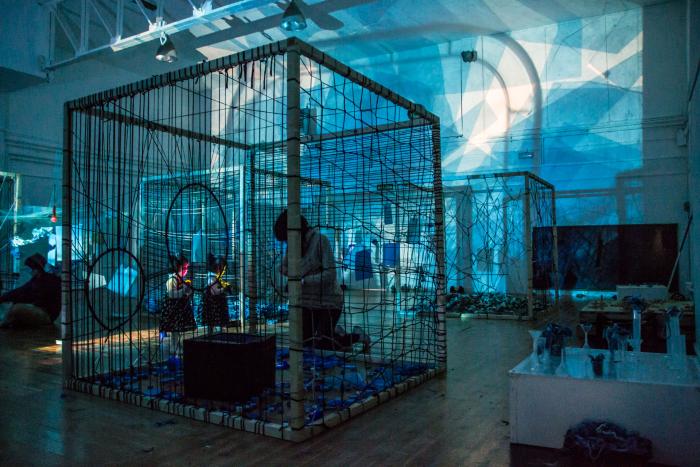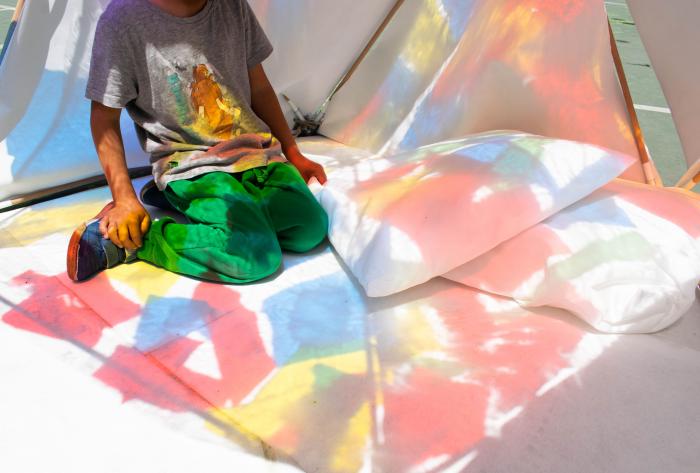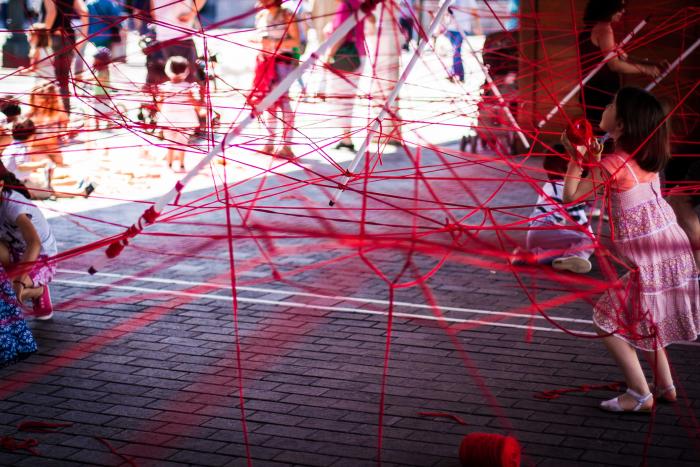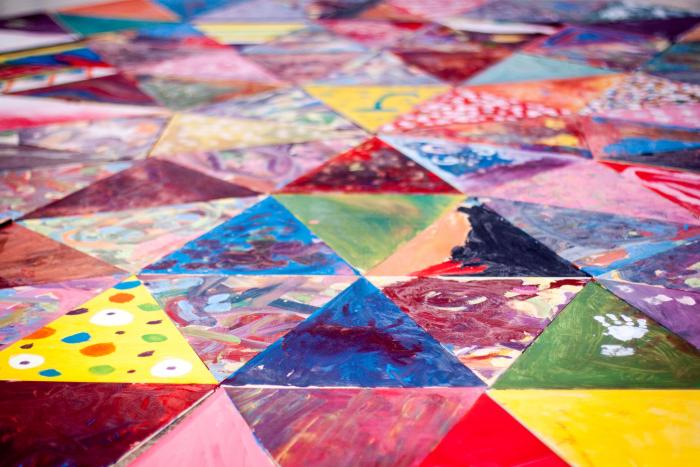I. SUMMARY INFORMATION
Project
267413
Status
Submitted
Award category
Interdisciplinary education models
You want to submit
NEW EUROPEAN BAUHAUS AWARDS : existing completed examples
Project title
CREATECTURA: Pedagogy + Art + Ecodesign
Full project title
CREATECTURA: Pedagogical innovation through Integrated Arts and Ecological Design
Description
We research into the potential of artistic languages for the transformation of learning spaces, with an approach based on sustainable development, respect for neurodiversity and advocating the importance of creativity and learning through experimentation and play. Createctura is made up of a multidisciplinary team of designers, artists and psychologists and develops its activities in schools and cultural contexts around the world with the goal of social transformation.
Where was your project implemented in the EU?
Spain
Cantabria
Barrio Brazomar 45 A
Castro Urdiales
39700
When was your project implemented?
Has your project benefited from EU programmes or funds?
No
Which programme(s) or fund(s)? Provide the name of the programme(s)/fund(s), the strand/action line as relevant and the year.
II. DESCRIPTION OF THE PROJECT
Please provide a summary of your project
Createctura is a pedagogical research and innovation project through the ecodesign of spaces, artistic integration and creativity development. It is the main project of the ILER (Innovative Learning Environments Research) Association which was set up in Cantabria (Spain) and currently also has national delegations in Madrid and Galicia. Our project is also represented in France through the “Association Createctura France”
The main objective of the Createctura Project is to conduct research into the potential of artistic languages in relation to the transformation of learning spaces, with an approach based on sustainable development, respect for neurodiversity and advocating the importance of creativity and learning through experimentation and play. It develops its activities in all kinds of school, cultural and artistic contexts in the international arena with a goal of social transformation.
We are mainly dedicated to four lines of action:
- Methodological and spatial transformation of schools through integrated design strategies: ecological redesign of the physical space; teacher training, support and empowerment; creation of pedagogical laboratories in the centers accompanied by artists trained in our approach; provision of natural and recycled pedagogical materials.
- Interactive and participatory artistic projects, based on collective creation, play and experimentation installed in museums, theaters, cultural centers and all kinds of public spaces.
- Training in our pedagogical innovation approach for professionals from the educational and artistic world from more than fifteen countries through different artistic integration, creative development and design tool that we have created: “Ephemeral Compositions”, “Ludic Landscapes”, “Inhabited Scenographies”, “Progressive Art”, etc. .
- Holding workshops in schools and family workshops on music and integrated arts, visual arts, design, experimentation and play, technology and creativity
Please give information about the key objectives of your project in terms of sustainability and how these have been met
CREATIVE REUSE OF MATERIALS. NEW USES FOR RECOVERED AND NATURAL OBJECTS. With recovered objects, aesthetically cared for, detached from their original function, we can create proposals that awaken our innate curiosity. In this fast-paced economic system we live in, an unprecedented amount of objects and materials are thrown away. They are easy to recover and this allows us to give them new lives. This also means that innovation projects through creativity in schools do not depend so much on the budget as on the will to perform them. Thanks to this we can also learn to take responsibility for what we discard; learn to consume less and more consciously.
CRADLE TO CRADLE APPROACH. Once the objects and materials we use deteriorate, we do not throw them away. We separate the natural from the technical materials. We have a small composting center for our natural materials. We constantly investigate new ways to generate the most closed cycles possible for technical materials such as recovered plastics, trying to avoid their consumption, but recycling what we get through recovery. We also disassemble the technological devices to use the fragments in new pedagogical and creative uses.
LOCAL RECOVERY OF MATERIAL. We avoid unnecessary consumption and try to develop a lot of our projects from the creative reuse in the pedagogical and artistic field of materials generated by local economic activities. Thus, we collect large quantities of different materials in the warehouses of our Ecocenter which we then use in our activities and distribute, generating networks and synergies for the compilation of new materials that we store on our premises and the schools that work with our approach.
DISSEMINATION OF ECOLOGICAL PRACTICES.We raise awareness among children and adults on the importance of reducing our consumption and learning correct recycling practices through eco-design, taking responsibility locally for the waste we generate and developing our creativity.
Please give information about the key objectives of your project in terms of aesthetics and quality of experience beyond functionality and how these have been met
Our entire approach is based on the importance of the aesthetic experience in the pedagogical spaces for development, learning and well-being. Aesthetics awaken our senses and our perception. This awakening is fundamental, because generating “spaces for amazement” connects with surprise and innate motivation, compared to traditional pedagogical spaces that tend to anesthetize the curiosity of our children. For this we use the arrangement of the materials through "Ephemeral Compositions", sound and light design and the creation of immersive "Ludic Landscapes", among others.
We use design, visual arts and scenography to generate friendly, beautiful and flexible learning environments that predispose us to connect with our most sensitive and creative part. In these immersive artistic environments that are activated through the action of the children who are the protagonists. We place ourselves in the role of learning companions. We know that the design of spaces can help in the pedagogical innovation process, because we have spent a decade investigating how the transformation of the environment can, among many other things, modify our perception and our emotion and therefore, the way we learn. We can multiply the proposals, learn flexible strategies instead of relying on conformity, in order to respond to the diversity of interests, talents and needs of our classrooms.
Extreme care in the presentation of materials and proposals predisposes everyone to take care of them. Children learn from a very young age to take joint responsibility for the environment they inhabit. The most banal objects and materials, also recycled ones, are treated with care and are revalued through artistic action. Our spaces teach through experience how to look after what surrounds us, the value of objects, the infinite potential of the imagination. Not only children, but also adults and families learn this change of outlook together, fostering the continuous improvement of our environment
Please give information about the key objectives of your project in terms of inclusion and how these have been met
The CREATECTURA project came into being to generate alternatives to the principles of uniformity, conformity and linearity that still apply today in many of our schools and that are not adapted to today's society, nor are they capable of responding to the diverse needs of our children.
The traditional educational system excludes because it is based on the ability of children to adapt to a pre-established school structure. Our most vulnerable children, those with different abilities, are the most affected.
We continue to be excessively conditioned by the ideas about the educational spaces that we have inherited and it is hard for us to question them, to realize that there are many options beyond the standardization of the classrooms.
At Createctura we work from and for diversity through the design of open, flexible proposals with different learning universes that work simultaneously dedicated to an intergenerational audience: children, adolescents, families and teachers. Diversity of environments and approaches with the aim of enriching and broadening the vision of what it means to educate.
Neurodiversity is for us a starting point and flexible design a fundamental work strategy. Having these types of strategies allows teachers to better respond to the diversity in their groups and to attend to special needs, which is very difficult to do in a traditional classroom.
Our objective is nothing more than to convert our schools into places of true inclusion, which is achieved when we all recognize ourselves as different and such diversity is celebrated from the conviction of its fundamental importance. Not accompanying the potential and difficulties of our children and adolescents respecting their differences is not only an individual drama that limits the opportunities of many of our students, but also has a high price in our society and our collective future.
Please give information on the results/impacts achieved by your project in relation to the category you apply for
The principles of sustainability, inclusion and aesthetics are the bedrock of Createctura and run through all of our work. Throughout these years we have developed different artistic-pedagogical strategies that illustrate the relationship of these principles with the learning processes and the curriculum.
The "Learning Scenographies" for example, break with the idea of repetition of identical classrooms, generating flexible and adaptable spatial structures that evolve through the actions and experiences of the students. They propose "pedagogical multiverses" where there are different simultaneous possibilities, attending to the diversity of learning styles and needs, overcoming the idea that learning is carried out in a uniform way: doing the same thing, in the same way, at the same time, at a table and a chair, inside the classroom.
Opposing needs, such as those of concentration and calm and those of greater motor expression and interaction, are taken into account thanks to the diversification of spaces and looking beyond the classroom as the only learning unit. Once the doors are open and the spaces connected, the opportunities multiply, the way of teaching and learning is necessarily transformed. The traditional compartmentalization of spaces and contents is overcome through the articulation of disciplines and interconnection of pedagogical universes, valuing the competence approach and not only the conceptual one. The strategies of the world of design applied to learning environments allow us to use scale, density, distribution, color, lighting or sound design, to innovate in education.
We conceive these proposals as laboratories, in which, the generation of working hypothesis and documentation is investigated through observation on processes, ideas, materials and experiences to evaluate them, thus producing a continuous feedback process which keeps us constantly open to new discoveries and serendipities.
Please explain the way citizens benefiting from or affected by the project and civil society have been involved in the project and what has been the impact of this involvement on the project
Createctura is a project with a social base, fostering cooperation between professionals and families, based on social participation.
For almost a decade, we have designed proposals for all types of school, artistic and cultural spaces, in different contexts, countries and continents, with thousands of children and people of all ages. We have seen hundreds of people pass through some projects who were immersed in this type of environment for the first time. In others, we have been able to follow small groups throughout many sessions, going deeper into into their evolution and the impact of this type of work. Some families have accompanied us since the beginning of this journey and our project has been developing over these years with them and their children.
Our proposals, through playing and art, welcome their participants and allow individual expression in community construction, questioning the categories and inviting us to overcome any identity fiction that limits and excludes. The installations become an excuse for union under a common goal, in which communication skills, teamwork, support, empathy are activated ... becoming a powerful tool for social transformation.
Throughout these years, we have woven a large network of teachers and people from the creative world committed to new ways of accompanying learning. At the same time, we have made it easier for each professional to weave their own collaboration networks, acting as promoters of their community. Families and other local agents have been included in the projects, making them participate in the proposals: from their design (gathering and transformation of materials), to their execution (actively participating).
Please highlight the innovative character of the project
One of our main objectives is the commitment to research and innovation in order to offer tools that allow us to face the challenges of this complex century and generate profound changes in our society. Specifically:
We work combining different disciplines (art, architecture, design, music, technology, education) to generate new paradigms, new places, new contexts.
We collaborate with other professionals forming multidisciplinary teams, generating synergies between people from the creative world and teachers, weaving a network at a national and international level.
We place special emphasis on attending to diversity, offering open and flexible proposals for the inclusion of all people, without exceptions.
We promote the participation of different entities, agents and groups, mobilizing the community and the social fabric.
We cultivate imagination and creativity as essential skills to generate new solutions for current and future problems.
We foster creative development practices in schools, consolidating a lasting methodological change, committed in turn to innovation.
We use collective play and creation as tools for social transformation, from a non-hierarchical approach in which all individuals can participate on an equal footing.
We serve the Agenda 2030 SDG (Sustainable Development Goals) promoted by the United Nations, reusing and researching on the transformation of waste and natural materials.
We focus on competence and transversal work, connecting action, emotion, thought, reflection and relationship.
We generate dynamics in which the impact of the project is amplified through the network which has been generated, the dissemination of our proposals and the training and support that allow other professionals to be inspired by our work in their specific context
Please explain how the project led to results or learnings which could be transferred to other interested parties
Commitment to social change is fundamental for us, which is actually why we emerged as a project. If we want to generate a change that has a structural impact, the transfer of the project is essential. For this reason, in recent years we have dedicated a lot of energy, not only to doing, researching and reflecting, but also to communicating and sharing our work, through face-to-face and virtual training in various languages, conferences and social networks.
In this visibility, we take great care so that the experiences can be reproduced by other professionals, based on their context, needs and resources, an aspect that we think has been key when connecting with other professionals. Today our pedagogical innovation work through creativity, experimentation and design has given us recognition in the international arena and our approach today inspires professionals from more than a dozen countries.
Through our training we provide simple and realistic guidelines that allow for the almost immediate development of strategies in the classroom. These strategies break with the traditional structure of schools and have a visible impact on students’ motivation, inclusion, the acquisition of skills, ecology, creativity, the change of perspective towards childhood, the connection with learning and aesthetic care.
We are proud to serve as an inspiration in this process of collective transformation and to have generated a large collaboration network, committed to pedagogical innovation and social transformation. Change is in our hands and every day we are more people in more places reimagining our learning spaces. Our mission as a project is to support these professionals, providing them with new resources and awakening that creative vision that today, more than ever, must be part of the teaching work and that allows us to expand the “space of the possible” in education.
Is an evaluation report or any relevant independent evaluation source available?
No
III. UPLOAD PICTURES
IV. VALIDATION
By ticking this box, you declare that all the information provided in this form is factually correct, that the proposed project has not been proposed for the Awards more than once under the same category and that it has not been subject to any type of investigation, which could lead to a financial correction because of irregularities or fraud.
Yes



